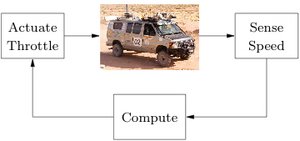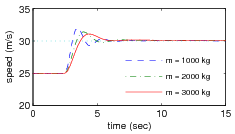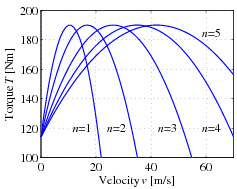Cruise control
This page documents the cruise control system that is used as a running example throughout the text. A detailed description of the dynamics of this system are presented in Chapter 3 - Examples. This page contains a description of the system, including the models and commands used to generate some of the plots in the text.
Contents
Introduction
Cruise control is the term used to describe a control system that regulates the speed of an automobile. Cruise control was commercially introduced in 1958 as an option on the Chrysler Imperial. The basic operation of a cruise controller is to sense the speed of the vehicle, compare this speed to a desired reference, and then accelerate or decelerate the car as required. The figure to the right shows a block diagram of this feedback system.
A simple control algorithm for controlling the speed is to use a "proportional plus integral" feedback. In this algorithm, we choose the amount of gas flowing to the engine based on both the error between the current and desired speed, and the integral of that error. The plot on the right shows the results of this feedback for a step change in the desired speed and a variety of different masses for the car (which might result from having a different number of passengers or towing a trailer). Notice that independent of the mass (which varies by a factor of 3), the steady state speed of the vehicle always approaches the desired speed and achieves that speed within approximately 5 seconds. Thus the performance of the system is robust with respect to this uncertainty.Dynamic model
To develop a mathematical model we start with a force balance for
the car body. Let  be the speed of the car,
be the speed of the car,
 the total mass (including passengers),
the total mass (including passengers),
 the force generated by the contact of the wheels
with the road, and
the force generated by the contact of the wheels
with the road, and  the disturbance force due to
gravity, friction and aerodynamic drag. The equation of motion of
the car is simply
the disturbance force due to
gravity, friction and aerodynamic drag. The equation of motion of
the car is simply

The force  is generated by the engine, whose torque
is proportional to the rate of fuel injection, which is itself
proportional to a control signal
is generated by the engine, whose torque
is proportional to the rate of fuel injection, which is itself
proportional to a control signal  that controls the throttle position. The torque also depends on
engine speed
that controls the throttle position. The torque also depends on
engine speed  . A simple representation of the
torque at full throttle is given by the torque curve
. A simple representation of the
torque at full throttle is given by the torque curve

where the maximum torque  is obtained at engine
speed
is obtained at engine
speed  . Typical parameters are
. Typical parameters are  Nm,
Nm,  = 420 rad/s (about 4000 RPM)
and
= 420 rad/s (about 4000 RPM)
and  .
.
Let  be the gear ratio and
be the gear ratio and  the wheel
radius. The engine speed is related to the velocity through the
expression
the wheel
radius. The engine speed is related to the velocity through the
expression

and the driving force can be written as

Typical values of  for gears 1 through 5 are
for gears 1 through 5 are  ,
,  ,
,  ,
,  and
and  . The inverse of
. The inverse of  has a physical interpretation as the effective wheel radius. The figure to the right shows the torque as a function of vehicle speed. The figure shows that the effect of the gear is to "flatten" the torque curve so that an almost full torque can be obtained almost over the whole speed range.
has a physical interpretation as the effective wheel radius. The figure to the right shows the torque as a function of vehicle speed. The figure shows that the effect of the gear is to "flatten" the torque curve so that an almost full torque can be obtained almost over the whole speed range.
The disturbance force  has three major components:
has three major components:  , the forces due to gravity;
, the forces due to gravity;  , the forces due to rolling friction; and
, the forces due to rolling friction; and  , the aerodynamic drag. Letting the slope of the
road be
, the aerodynamic drag. Letting the slope of the
road be  , gravity gives the force
, gravity gives the force  , where
, where  is the gravitational constant. A simple model of rolling friction is
is the gravitational constant. A simple model of rolling friction is

where  is the coefficient of rolling friction and sgn(
is the coefficient of rolling friction and sgn( ) is the sign of
) is the sign of  or zero if
or zero if  . A typical value for the coefficient of rolling friction is
. A typical value for the coefficient of rolling friction is  . Finally, the aerodynamic drag is proportional to the square of the speed:
. Finally, the aerodynamic drag is proportional to the square of the speed:

where  is the density of air,
is the density of air,  is the shape-dependent aerodynamic drag coefficient and
is the shape-dependent aerodynamic drag coefficient and
 is the frontal area of the car. Typical parameters are
is the frontal area of the car. Typical parameters are  1.3 k/m
1.3 k/m ,
,  and
and  2.4 m
2.4 m .
.
SIMULINK model
The file cruise_ctrl.mdl contains a nonlinear model of a cruise controller for a car, depicted below.

The model contains all of the dynamics described in Section 3.1.
MATLAB model
An alternative model for the system is a MATLAB model suitable for use with the 'ode45' function. The file {{{2}}} contains a nonlinear model of the car dynamics consistent with the description given in Section 3.1.
MATLAB files
A number of MATLAB files are available that correspond to examples in the printed text. This section contains links to the various files that are available. Note that you will also need some of the MATLAB tools.
Standalone versions of the model:
- cruise_ctrl.mdl - SIMULINK model for cruise controller in Section 3.1
- cruisedyn.m - MATLAB function to compute the acceleration given the vehicle state, inputs and parameters
Linearized models (all files required):
- cruise_carpar.m - Parameters for car model
- cruise_opcon.m - Defines default operating condition
- cruise_lin.m - Linearized model of the car dynamics
- cruise_conpar.m - Parameters for PI controller (including anti-windup)
- cruise_clsysode.m - Closed loop dynamics for linear and nonlinear models (including anti-windup)
Controller designs (require linearized models):
- cruise_pictrl.m - Basic proportional plus integral controller (Example 5.1)
- cruise_statefbk.m - State feedback controller, with integral action (Example 6.10)
- cruise_antiwindup.m - PI controller with antiwindup compensation (Example 10.5)
Exercises
The following exercises make use of the cruise control model described here:
Further Reading
- How Stuff Works: cruise control
- Wikipedia: cruise control


